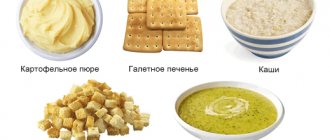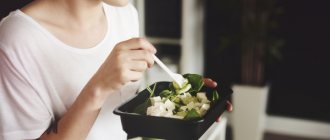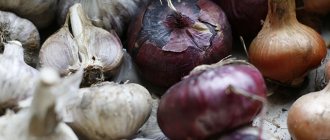Table No. 5 according to Pevzner is considered one of the best special diets prescribed for problems with the bile ducts and bladder, liver, and pancreas. Diet 5 for children is characterized by a cleansing and health-improving effect, based on the complete rejection of foods that provoke complications. The daily menu for such a diet contains dishes that normalize the functioning of the digestive organs and do not irritate them. The 5th table diet is the background on the basis of which effective therapy for the disease is carried out.
General Diet Recommendations
The main requirement that needs to be met when dieting table No. 5 for children is to eat in small portions. You need to feed your baby at least 5-6 times a day. This will promote regular flow of bile. Food should be adjusted for the presence of proteins and carbohydrates. This diet excludes the use of products containing cholesterol, oxalic acid and essential oils. Fried foods are prohibited.
With this diet, all the nutrients necessary for the growth and development of the child’s body are supplied in sufficient quantities. If you follow this regimen, your child’s digestive problems will fade into the background.
It is recommended to steam or boil food. It is impossible to give a child a dish hot or, on the contrary, cold: it should only be warm.
Features of diet number 5 for children
The peculiarity of baby food is that it must contain all the nutrients necessary for proper growth and development. A child should not be limited in many foods, nor should the amount of proteins, fats and carbohydrates be greatly reduced. But for diseases of the digestive organs, it is important that food does not irritate them or cause aggravation.
The goal of diet number 5 for a child should be to reduce the load on the stomach, pancreas, liver, and gall bladder. It is designed to slow down the development of the disease, prevent complications, and alleviate the patient’s condition. Therefore, parents need to try to adhere to its rules. Such nutrition is the basis of treatment and speeds up recovery.
Indications for use
Diet 5 for children is prescribed by a doctor. It is used in hospital settings and sanatoriums. But it is easy to follow it at home. Indications for use include the following pathologies:
- chronic pancreatitis;
- inactive stage of hepatitis;
- gastritis or gastroenteritis;
- biliary dyskinesia.
Diet rules table 5 for children
This diet is beneficial for the child, as it is balanced in nutritional content and includes a variety of foods. The most important rule to follow is to completely eliminate all prohibited foods. They can cause aggravation and slow down the child's recovery.
But parents need to know other rules, as well as the features of cooking:
- The child should not be overfed; portions should be small. But you need to increase the number of meals. It is recommended to feed the baby 5-6 times a day - this is every 2.5-3 hours. This will improve digestion and accelerate the flow of bile;
- Fried foods are completely prohibited. Food can only be boiled. It is acceptable to steam or bake without golden brown crust;
- the amount of fat in food decreases. It is advisable to exclude animal fats;
- you need to limit the content of salt and sugar;
- all food should be warm, soft, easily digestible. Cold or hot foods are prohibited;
- Children under 3 years old can be given vegetable and meat purees in baby food jars. They are pureed and do not contain any harmful additives;
- Every day a child should drink 1.5-2 liters of water.
Allowed products: table
Diet table number 5 for children includes a list of foods necessary for the body. The emphasis is on protein products. Fats should be excluded. This is clearly demonstrated in the table.
| Product category | Allowed |
| Meat and fish | Low-fat types (beef, veal, rabbit, perch, crucian carp, cod, pike perch). Use boiled and baked |
| Bird | Boiled chicken, turkey fillet |
| Flour | Stale bread. Galette cookies |
| Cereals | Buckwheat, oatmeal, semolina, rice - in the form of boiled, viscous porridge. Pasta made from durum wheat is allowed |
| Soups | Vegetarian soups made with vegetable broth from recommended cereals |
| Milk | Low-fat cheese, yogurt, cottage cheese, milk |
| Vegetables | Cabbage, fresh tomatoes, cucumbers, young greens. Eat boiled zucchini, onions, beets and carrots |
| Fruits | Watermelon, peaches, bananas, apricots, pears, melons, apples. Non-acidic berries: blueberries, strawberries. Dried fruits. |
| Beverages | Tea without steeping, fruit juices, compotes made from dried fruits |
Allowed foods for diet table No. 5
Main dishes are prepared from lean types of meat. Beef, veal, rabbit, chicken, and turkey are allowed. Suitable fish include pike perch, pike, cod, and bream. Vegetable soups and milk soups are also suitable as first courses.
Sources of carbohydrates include oatmeal and buckwheat. Pasta is also acceptable as a side dish. Vegetables can include carrots, tomatoes, potatoes, beets, cucumbers, cauliflower, broccoli and zucchini.
Allowed on Diet 5 for children are condensed milk, low-fat cottage cheese, a small amount of sour cream, kefir, and yogurt. For sweets, offer your child non-acidic fruits, a little sugar in tea, honey, marmalade, and marshmallows.
Prohibited and restricted foods in the diet
For a child, diet table No. 5 involves avoiding foods that can have a negative effect on internal organs. The diet of a sick child excludes or limits the use of a certain type of food. If you have digestive problems, you should not eat some previously favorite foods.
| Product category | What is prohibited |
| Bakery products | Pancakes, baked goods, fried and puff pastries, wheat bread today |
| Fish | Dried and smoked products, canned food |
| Meat and poultry | Smoked, canned. Sausage. Fat duck or goose, heart, kidneys, liver, cooking fats, pate |
| Milk | Fat cheese, sour cream, cottage cheese, fermented baked milk, butter (in large quantities) and margarine |
| Products that enhance fermentation and rotting | Peas, beans, beans, soybeans, millet |
| Vegetables | Spicy and bitter - sorrel, radishes, green onions, garlic, as well as mushrooms, pickles and pickled vegetables |
| Fruits and sweets | Chocolate, ice cream, sour berries and fruits (citrus fruits, cranberries, plums) |
| Beverages | Cocoa, black coffee, spirits even with low alcohol |
| Spices | Pepper, mustard, and horseradish should not be present in the diet menu. Salt should be limited as much as possible - up to 10 g per day |
Healthy recipes for kids
Table 5 imposes a ban on a number of products. However, this does not prevent children from being fed tasty and varied dishes. Diseases of the digestive system do not exclude the consumption of vegetable and meat stews, lean meats, fish, various cereals, as well as fruits and desserts.
White omelette
One of the light and healthy dishes. The easiest way to prepare it is in a double boiler. You should take a couple of fresh eggs, break them and separate the whites from the yolks. Egg whites have almost no cholesterol. Add salt and milk, a spoonful of vegetable oil, and beat well with a blender. Place the container with the resulting mixture in a double boiler. The dish takes about 10 minutes to prepare and can be served.
Vegetable casserole
The casserole is especially popular in the summer-autumn season, when the assortment of fresh vegetables is richest. The set of vegetables includes zucchini, peppers, and eggplants. They fully comply with the requirements of the diet of table 5. They are cut into cubes, add a little grated cheese and the white of one egg. Everything is thoroughly mixed. The container with the contents is covered with foil and placed in a double boiler. The finished casserole is salted to taste and sprinkled with finely chopped herbs.
Beetroot cutlets
There is no meat in beet cutlets; this is an exclusively dietary dish. Its main ingredients are beets and other vegetables, as well as binding ingredients: flour, semolina, chicken egg.
When considering your diet, be guided by your child’s taste preferences.
To obtain such a dish, you need to boil the beets, grate them, add a raw egg and salt. Then add semolina and distribute it over the beet mass. After this, you need to make cutlets from the beetroot “minced meat”. Now you can fry them in oil. During the frying process, it is advisable to cover the pan with a lid so that the cutlets are additionally steamed.
Fish casserole with vegetables
To obtain this dietary dish, preheat the oven to 160 degrees. Arrange the casserole in layers in a roasting pan. Place potatoes on the bottom, which need to be salted and peppered, then carrots. Grease with mayonnaise or sour cream.
Next, fish fillets cut into thin slices are placed. Everything is poured with lemon juice, seasoned with spices, sprinkled with salt and covered with onions. Slices of zucchini are placed on top of the onions, and tomatoes are placed on top. Salt is added again, as well as pepper and grated hard cheese. The container is placed in a preheated oven for 35-40 minutes. Once the casserole has cooled, it can be served.
Lazy dumplings with berry sauce
You need to stock up on cottage cheese, sour cream, eggs, sugar, semolina. All ingredients are mixed and set aside for half an hour until the semolina swells. At the same time, the sauce is cooked. Sugar is added to the berries, and the container with the mixture is placed on the fire. Then starch dissolved in water is poured into the contents, the liquid is brought to a boil, and the fire is turned off.
Heat water in a wide saucepan. Flour is added to the curd mixture, pieces of dough are plucked from this mass, from which small balls or rolls are made. The resulting dumplings are thrown into boiling water and cooked until they float to the surface. The finished dumplings are taken out, poured with butter and berry sauce, and served.
Oat cookies
This type of baking does not require flour. Diet cookies for table 5 are made from oatmeal and eggs. No oil needed either. Oatmeal is ground in a coffee grinder and a handful of raisins is added to it. Beat 2 chicken eggs, adding 3 tsp. sugar, a pinch of vanillin and cinnamon. Place a baking sheet with cookies laid out in it in an oven heated to 180 degrees. Bake for 15-20 minutes.
Pumpkin Noodle Casserole
You need about a glass of grated fresh pumpkin, 200 g of noodles, half a glass of milk, 1 egg, 2 tbsp. l. sugar and 1 tbsp. l. butter. Add salt and sugar to the pureed pumpkin and simmer until soft. The noodles need to be cooked separately. Then butter and milk are added to it. The mixture is set aside for 30 minutes. Then an egg is broken into the contents, everything is laid out on a baking sheet and placed in the oven for 20 minutes. Cool the finished casserole, apply a layer of sour cream and serve.
Protein omelet with cheese
Required ingredients:
- 2 chicken eggs;
- 2 tbsp. l. milk;
- 10 g cheese;
- a pinch of salt.
For the omelet you will need butter. It should be melted in a frying pan. Place egg whites in a common container with milk, but do not shake. Pour the mixture into a hot frying pan. After 3-4 minutes, sprinkle the omelette with grated cheese and cover with a lid for 2 minutes. Then remove the omelette. Serve with sour cream.
Vegetable caviar
Prepared as an addition to main dishes. For caviar you should take 2 potatoes, 1 carrot, 1 fresh cucumber, 1 onion. You will also need vegetable oil and salt.
Potatoes and carrots need to be boiled whole, then cooled, peeled and cut into large portions. Also cut the onion into large pieces and fry it in a frying pan. Finely chop the cucumber. All components are processed in a meat grinder. The mixture prepared in this way is seasoned with vegetable oil, salt is added to it and mixed well. The caviar is ready.
Sample menu for the week
If there is a child at home with liver and gall problems, it is important to have a long-term menu. It includes products that will benefit the body. The menu for every day of the week, corresponding to diet table No. 5, includes dishes prepared according to the best recipes for children.
As an example, here is a sample menu.
Monday
- Breakfast – cottage cheese casserole. Raisin compote.
- Lunch – banana with walnuts.
- Lunch – chicken baked in the oven. Unsweetened strong tea.
- Afternoon snack - cottage cheese. Lingonberry juice.
- Dinner – a piece of stewed pink salmon in vegetable sauce. Vegetable salad in vegetable oil.
Tuesday
- Breakfast – semolina porridge with cherry jam. Milkshake.
- Lunch – carrots and apples in salad.
- Lunch – vegetable soup with sour cream. For the second course - milk porridge.
- Afternoon snack – a glass of low-fat milk. Oat cookies.
- Dinner – beet salad with prunes. Low-fat kefir.
Wednesday
- Breakfast – rice casserole. Tea with milk.
- Lunch – vegetable puree.
- Lunch – buckwheat soup. Salad with cabbage and cucumbers.
- Afternoon snack – carrot salad.
- Dinner - kefir. Boiled yolk.
Thursday
- Breakfast – pancakes with dried apricots. Curd. Low-fat cheese.
- Lunch – apple.
- Lunch – baked beef. Green tea.
- Afternoon snack – steamed omelette.
- Dinner – soft-boiled eggs.
Friday
- Breakfast – protein omelet with vegetables. Compote.
- Lunch – kefir. Rice porridge with stewed cabbage.
- Lunch – beetroot borscht. Pea puree.
- Afternoon snack – rice pudding. Baked apple.
- Dinner – baked meat. Rose hip decoction.
Saturday
- Breakfast - a piece of cheese and stale bread. A glass of low-fat sour cream.
- Lunch – cottage cheese with fresh berries. Compote.
- Lunch – fish balls. Rice. Strawberry jelly.
- Afternoon snack – apple juice. Crackers.
- Dinner – cabbage rolls with turkey meat. Salad with prunes.
Diet table 5 for a child: menu for the week
If parents create the menu themselves, it is recommended to plan it for the week. At the same time, try to make it varied. Include as many permitted foods as possible, then you will be able to provide the patient with all the necessary nutrients. But at the same time, you need to focus on those dishes that the child likes, so that he eats with pleasure.
When creating a menu, it is better to first use the advice of nutritionists or ready-made options.
- For breakfast, porridge is most often cooked in low-fat milk. This is buckwheat, rice or oatmeal. It is made with dried fruits or apples. You can also make a protein omelet or cottage cheese casserole;
- second breakfast consists of a baked apple, carrot cutlets, cheesecakes or yogurt;
- for lunch you should definitely cook soup in vegetable or low-fat chicken broth; It could be borscht, noodles, beetroot soup. Possibly with meatballs. For the second course, boiled or baked chicken, meatballs or steamed cutlets. Side dish – buckwheat, rice, stewed zucchini, mashed potatoes. You can make pilaf;
- For an afternoon snack, fruit salad, yogurt, cheesecakes, manna cake are suitable;
- In the evening it is better to boil or bake fish. It is served with stewed vegetables, rice or mashed potatoes. You can also make chicken tenders or meatballs. Additionally, you can give your child a salad of cucumbers and tomatoes;
- An hour before bedtime, it is recommended to drink a glass of kefir, acidophilus or natural yogurt.
Each meal is complemented by a drink. For breakfast, weak tea is best. For lunch and dinner, juice, dried fruit compote, fruit juice or rosehip decoction. During the afternoon snack, you can drink jelly or fermented milk drink. It is recommended to teach your child to drink a glass of clean water half an hour before meals.










